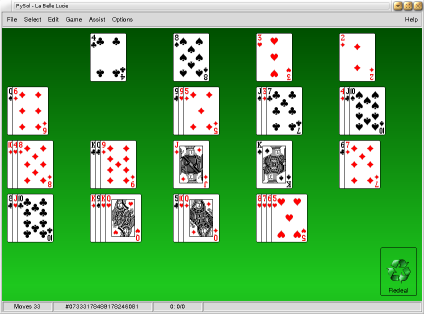I’ve just written about how I’ve begun playing solitaire games,
especially La Belle Lucie — accourding to PySol this game is
also known as Clover Leaf and Midnight Oil. I’ll call it La Belle
Lucie. The rules are quite easy:
Move all cards to the foundations to win.
The piles must be built in suit.
Only one card can be moved one at a time.
Now let me share what little I’ve found out with regards to a strategy
for the game. Below is a screenshot of a typical situation in the
game. Click on it to have it enlarged to full size.

The piles on the tableau can be divided into two types, the first of
which you will want to leave alone:
Locked piles. These are piles where the top cards are in sequence
and of the same suit. There the top card cannot be moved. This is
because La Belle Lucie is played with just a single deck and so
there is just one correct position for each card. Note that the
kings cannot be moved onto any other card, so any pile with a king
at the top is automatically locked.
An example of a more common locked pile is the one with the Queen of
Hearts (♥Q) at the top: that
card can only be put on the King of Hearts (♥K), it card cannot be moved elsewhere. So that
pile is effectively locked.
Piles with just one card also fall in this category. Even if the
card in these “piles” could be moved to another pile it should never
be done — since there’s just a single card moving it wont help
anything since there’s no buried cards to reveal. So moving the
card can never help.
The Jack of Diamonds (♦J) is an example of such a lonely,
but valuable, card.
Other piles, that is piles where the top cards does not form a
sequence. These are the only cards that you will have a chance of
moving, since all other cards are either locked or singletons.
Moving a card to another pile locks that pile since the two top-most
cards now form a sequence and are of the same suit. That means that
you should be careful when you move cards: always check first that the
top card in the target pile cannot be moved.
In the example we could move the ♦5 onto the ♦6, but this would be a bad move since it locks the
♦6, which could have been moved
to ♦7, which itself could have
been moved with ♦8 to ♦9. At that point we reach a dead end
in the moving, for ♦9 can only
be moved onto ♦10, but that card
is buried beneath ♦8 and ♥4. So to move ♦9 we would have to move ♦8 — but this card can only be placed on ♦9 and so we have no chance of moving
♦9. This effectively means that
♦9 is locked and so we can
safely moved ♦8 onto it,
followed by the other cards in the sequence.
This is the basic strategy: move unlocked cards onto locked cards.
Continue doing this until all cards are part of locked piles or until
no card can be moved. Then redeal and do it all again :-)
The cards in the foundations sometimes make things a little more
subtle by giving you two ways of moving a given card. If, for
example, you want to get rid of the ♣7 card so that the ♦3 is revealed, then you have two ways
of doing this: moving ♣7 unto ♣8 on the tableau, or
getting ♣6 on the foundation and then moving ♣6 there too.
The problem of getting hold of ♦3 is equivalent to solving either of these two
sub-problems. Always think in terms of such back-tracking: “if I want
this card, then I have to move that card, which means that this other
card most be moved…” Stop your back-tracking when you hit a cycle
like above.
That’s it — if you know of anything extra worth noticing when
playing La Belle Lucia please let me know!
It would also be very interesting to hear something about the
statistics of the game: how often do you actually have a change, on
average? The problem is that you might be unlucky in your last redeal
and end up with a king at the top of a pile with another card from the
same suit beneath the king. In that case you cannot win since the
king cannot be moved, and thus the buried card is lost. I hate when
that happens… :-)

